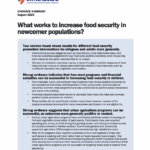The notion of cultural acceptability is often called forth as a necessary component of food security, yet there is a lack of guidance in literature and policy as to how to operationalize this concept. Without specifying what cultural acceptability means, the concept risks becoming watered down, discounted, or obsolete in practice. This review strives to speak to those gaps by cataloging the connotations and implications of cultural acceptability in literature on urban food policy, food security, and associated topics. We explore the ways in which cultural acceptability has been invoked explicitly and implicitly in policy, planning, and scholarly literatures on food security in recent years in order to better understand what cultural acceptability has come to mean, how it is being utilized, and how it can be operationalized toward more flexible and appropriate urban food policy. We discuss ways in which cultural acceptability encapsulates more than certain types of food and literature that might provide dimension to the meaning and operationalization of cultural acceptability of food. Drawing on scholars that are breaking open understandings of cultural acceptability, we call attention to its complexity with reference to human rights-based approaches, cultural values evident in production and consumption processes, the importance of interweaving multiple knowledges, and challenging decision-making powers in today’s corporate food regime. Cultural valuations within these broad and fluid topics can provide important improvements to policy approaches to the cultural acceptability of food and are important for creating food security policy that is effective for meeting the needs of diverse populations.
A Systematic Review on the Impact of Trauma-Informed Education Programs on Academic and Academic-Related Functioning for Students Who Have Experienced Childhood Adversity
The purpose of this study was to conduct a systematic review of the existing literature regarding trauma-informed education programs and their impact on academic and academic-related outcomes. The articles included for review (n=15) contained data on trauma-informed education programs implemented in preschool, primary/elementary, and high school settings. Academic and academic-related outcomes reported included attendance, disciplinary…

